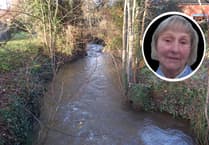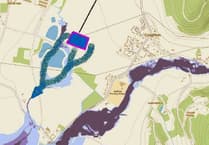THE re-opening of the Wireworks Bridge at Tintern, as reported in last week’s Forester, is good news, but the completion of the bridge repairs came too late to save me from a frustrating afternoon in the area the previous week.
No-one told me that the Wireworks Bridge had been closed, so I set out with some visitors that week to take the circular walk from the Old Tintern Station Heritage Centre to Brockweir Bridge, along the Gloucestershire side of the River Wye, along part of Offa’s Dyke path, crossing the Wireworks Bridge in Tintern, and back past the ancient St Michaels church at Tintern Parva and so to the Station along the Monmouthshire side of the Wye.
At least, that was the plan, until we discovered while approaching the Wireworks Bridge towards the end of the walk that it was closed for some repairs.
There was nothing for it but to retrace our steps back along the Wye, through Brockweir and so to the station.
We were not the only walkers to have made that mistake, and there were quite a few other ramblers accompanying us on our reverse journey.
There can be few more glorious settings than the Wye Valley to make a return journey.
Back at the station there is a fabulous collection of life size carvings of legendary, mythological and historical personages in this borderland where ancient Saxon and British/Welsh cultures meet.
There is the mythological Sabrina, Roman deity of the River Severn, half woman (top half) and half fish (bottom half).
The local Welsh king Tewdrig, who either renounced his kingdom to live as a hermit on an island in the Severn estuary, or was killed in battle against the invading Saxons (sources differ, we may never know), is also commemorated.
The other carvings depict the legendary Arthur of the Round Table, who was introduced to the contemporary reading public by historian Geoffrey of Monmouth, another regional personality, and the Mercian King Offa, and Eleanor of Provence, wife of Henry III, who seems to have only a tenuous connection to the area.
The station at Tintern is one of several on the old Chepstow to Monmouth railway line that closed down in 1959.
The line crossed the Wye at Chepstow into Gloucestershire, and then followed through the old sleepy Netherhope halt to Tintern, Redbrook and Monmouth.
It was good to see that the former rail tunnel from Tidenham to Tintern is now incorporated into the cycle track from Sedbury to Tintern, via the old National Diving centre at Tutshill.
Further up the river there was a St Briavels halt, which was not in St Briavels or even in Gloucestershire, but was used to drop off provisions and newspapers for St Briavels at the Bigsweir Halt building, which still survives.
The Redbrook railway bridge, now a footbridge, is the only way for customers from the Gloucestershire side to get to the Boat pub directly over the river without the long detour through Monmouth and Penallt.
The lower Wye valley has many industrial, literary and other cultural treasures, and with the repairs to the Tintern Wireworks Bridge now completed I hope that walkers and cyclists will continue to enjoy exploring this unique area of local history.





Comments
This article has no comments yet. Be the first to leave a comment.